Concrete issues: rabbits, discolouration and cracking
1. Our first claim relates to a Timaru driveway that was laid by our client’s subcontractor but rejected by the head contractor as being of poor quality. They had it ripped up and our client and the subbie laid a new drive, at their cost. The main contractor held our client liable for the cost of the demolition. It was subsequently established that the concrete supplied (by the head contractor) was contaminated with pieces of dead rabbit (they had apparently been living in the aggregate used in the mix), which is what caused the quality issue. The insurer has denied liability on our client’s behalf and is counter claiming for their costs.
2. Our second concrete claim relates to the discolouration of a polished concrete floor laid in a Northland home early 2018. The insured and the concrete supplier tried various fixes including grinding it back and resealing it, but the stains returned. A claim was not made until 18 months later, at which point the insurer engaged experts to try and determine the cause and who was liable. In November 2020 the loss adjuster determined that the only feasible remediation was to cover the affected areas and a settlement offer was made to the third party on this basis.
3. Our third concrete claim relates to spidery cracks that appeared in a residential driveway laid in Wanaka in September 2019 by a subcontractor to our client, the builder. The concrete placer stopped responding to our client’s requests to remediate the issue and a claim was lodged in May 2020. The insurer has requested a quote to replace the driveway and intends to hold the placer liable and recover their costs.
Grout discolouration
Our Auckland-based insured was contracted to tile a new bathroom in January 2020. Subsequently the grout began to discolour. An independent assessment was conducted and the cause determined to be a problem with the grout mix prepared by the tiler. The third party wanted another tiler to complete the remediation work and a cash settlement of $13,500 was paid, with the insured contributing $1,000 as their excess under the faulty workmanship clause.
Failed waterproofing of a shower
Another claim related to the discovery in March 2020 of a leak and significant timber damage during the renovation of a home in Hawkes Bay. The cause was traced to problems with the waterproofing of a tiled shower, work performed by our insured in 2017. The damage must have begun at some time between 2017 and March 2020, however determining the precise date when timber becomes damaged by moisture is an expensive scientific exercise. This date is important, as when the damage occurred is the trigger for a public liability claim, and it is the insured’s responsibility to prove this. Our client was also uninsured for a long period between these two dates, as they had chosen not to continue their coverage for a time when they were not working. While the insurer was within their rights to decline the claim, we convinced them to offer a settlement based on the proportion of time they were “on risk” between the work being done and discovery of the damage.
There is a good lesson here that even if you are in between jobs you should maintain continuous liability coverage. Damage can happen many months or even years after you actually did the work, and it is when the damage actually happens, not when you did the work, that is the trigger for the claim. So that is when you need the policy to be in place.
LBP Complaint
In January 2020 our client replaced a window and did some minor cladding repairs. It was understood that the work would not include finishing as the homeowners wanted to keep costs down by doing the prep and painting work themselves. They were also unwilling to pay for scaffolding and supplied a secondhand window. Upon completion of the work the homeowners refused to pay the final invoice and alleged that the work was below standard and included faulty workmanship. They threatened to complain to the Building Practitioners Board (BPB) and post disparaging online reviews if not provided with a full refund. In May 2020 a complaint was lodged with the BPB and a claim under the insured’s statutory liability insurance was made. Lawyers were appointed to act on behalf of the client and a submission to the BPB was made refuting the complaint. In September 2020 the BPB elected not to uphold the complaint or hold a hearing on it. In their decision they stated that “whilst there was some evidence of building work that may not have been completed to an acceptable standard, the matters raised did not reach the seriousness threshold [required].” Legal fees paid under the insured’s policy amounted to in excess of $18,000.
Accidental damage: a dropped chisel, a misplaced step and a cracked benchtop
1. In September 2020 a builder was installing soffits when he dropped his chisel, smashing a large window. The claim was settled for a little over $3,000 within 10 days of notification.
2. In October 2020 a plasterer stepped back and cracked a ceramic cooktop. The claim was settled within 8 days, for a little over $500 after subtracting their excess.
3. A stone benchtop had cracked when the builder lifted it to adjust the position of the cupboards underneath. A claim under the contract works insurance policy was declined on the basis that the damage was caused by faulty workmanship. We disputed this and pursued it strongly but were not successful. Instead, we lodged a claim under the insured’s liability policy, which was with a different insurer. The liability insurer agreed that the benchtop was owned by the third party and the damage was accidental not faulty workmanship. This triggered settlement of the claim to the value of circa $7,000, less a $1,000 excess due to the benchtop being in the care, custody and control of the insured at the time of the loss.



